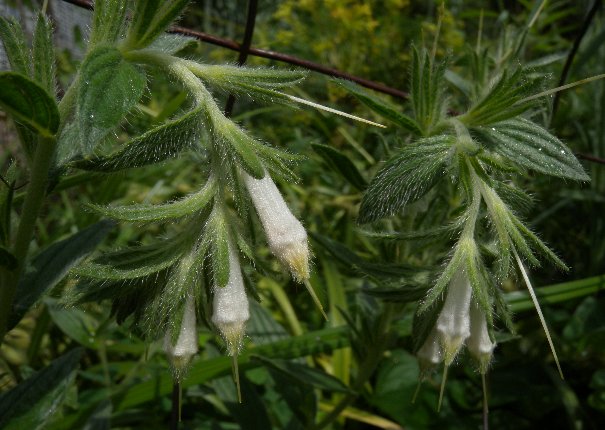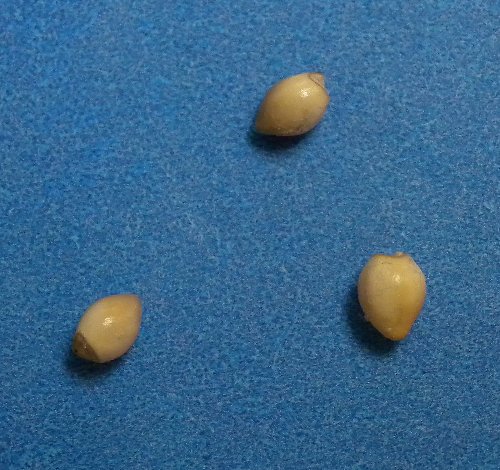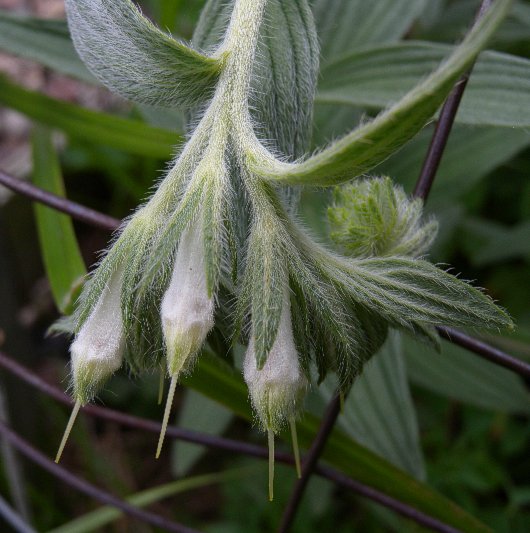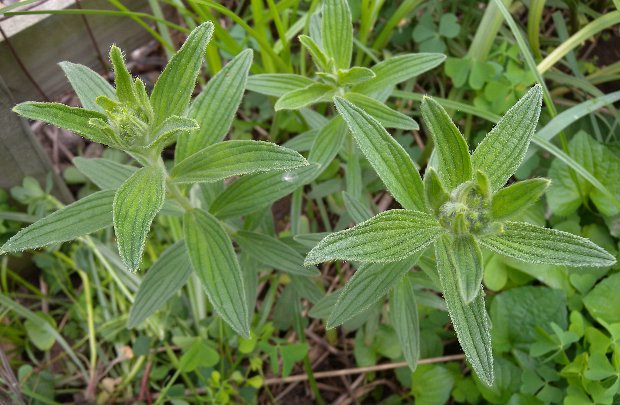
Each flower has a white corolla that is ½–¾" long, a hairy green calyx with 5 slender lobes, 5 inserted stamens, and a pistil with a strongly exerted white style. The corolla is cylindrical-angular in shape, becoming slightly and gradually wider toward its tip. At the tip of the corolla, there are 5 triangular lobes that extend outward and inward, effectively closing off the opening of the corolla, except for the exerted style. These lobes are often tinted green or yellow. The outer sides of the corolla are densely canescent, except where its lobes occur; the latter are hairy throughout. The lobes of the calyx are linear-lanceolate to linear-oblong in shape. Including its lobes, the calyx is about two-thirds as long as the corolla. The pedicels of the flowers are up to ¼" long (rarely longer); they are whitish green, terete, appressed-pubescent, and covered with appressed to slightly spreading hairs. At the bases of these pedicels, there are solitary bracts up to 1" long that resemble the leaves. The blooming period occurs from late spring to mid-summer, lasting about 3 weeks. There is no noticeable floral scent. Afterwards, the raceme uncoils itself and becomes more straight and erect; each flower is replaced by 0-4 nutlets (often, there is only a single nutlet per flower). Mature nutlets are 3.5–4.5 mm. long, 2.5–3.5 mm. across, and ovoid in shape; their tips are bluntly acute, while their bottoms are more or less truncate and discolored. There is no ring-like constriction near the base of each nutlet. The sides of these nutlets are pale brown to white and either dull or shiny; they are usually devoid of small pits, although sometimes a few scattered pits may occur. The nutlets are also quite hard. The root system consists of a deep taproot. This plant reproduces by reseeding itself.

Cultivation: The preference is full sun, mesic to dry conditions, and soil containing gravel, sand, or rocky material. While this plant readily adapts to more fertile loamy soil, it is typically found on more barren ground because of the reduced competition from other kinds of ground vegetation. Most growth and development occurs during the spring and the first half of summer; this plant has a C3 metabolism. The hard seeds may lie in the ground for several years before they germinate.
Range & Habitat: Western Marbleseed is found in the western half of Illinois and at the Shawnee Hills in the southern section of the state (see Distribution Map). It is native to the state and uncommon. Illinois lies along the eastern range-limit of this species. Western Marbleseed has a rather large range that extends across the Great Plains and into some of the western states. In Illinois, habitats for this species includes upland sand prairies, upland gravel prairies, hill prairies, upland savannas, rocky glades, and upland pastures. This plant is normally found in high quality natural areas, although it appears to thrive better when there are occasional wildfires or cattle grazing.

Faunal Associations: The flowers are cross-pollinated primarily by bumblebees. Other insect visitors of the flowers include honeybees, Halictid bees, ants, and true bugs (Williams, 1998). Both nectar and pollen are available as floral rewards. Other insects feed on the foliage, stems, sap, and other parts of Marbleseed (Onosmodium molle). Adult flea beetles (Epitrix spp., Longitarsus spp.) feed on the leaves, while their larvae feed on the roots. One species, the Marbleseed Flea Beetle (Longitarsus subrufus), is oligophagous on Marbleseed. Other insect feeders include polyphagous stink bugs that feed on the sap of the stems, stem-boring larvae of gall flies (Neolasioptera spp.), and pollen-feeding larvae of a sap beetle (Afrogethes saevus). Species that feed on sap from the leaves include the Two-striped Planthopper (Acanalonia bivittata), Meadow Spittlebug (Philaenus spumarius), and Girdled Leafhopper (Aphrodes bicincta). The larvae of a moth, the Marbleseed Leafminer (Acrocercops pnosmodiella), is oligophagous on marbleseed. Larvae of another moth, the Streaked Ethmia Moth (Ethmia longimaculella longimaculella), feed on the leaves of marbleseed and puccoons (Lithospermum spp.). Larvae of some polyphagous tiger moths and larvae of a polyphagous butterfly, the Painted Lady (Vanessa cardui), also feed on the leaves marbleseed. For more information, see Williams (1998), Powell (1973), and Needham et al. (1928). The foliage of marbleseed is not a preferred source of food for mammalian herbivores because of its bristly hairs. This plant usually becomes more abundant in upland pastures that are occasionally grazed by cattle (Williams, 1997). Like other species in the Borage family, the foliage of marbleseed may contain pyrrolizidine alkaloids that are toxic to the liver.
Photographic Location: The wildflower garden of the webmaster in Urbana, Illinois.

Comments: Western Marbleseed is another plant that is native to Illinois prairies. Its flowers are somewhat odd-looking because of their closed corollas. The taxonomy of marbleseed (Onosmodium) has been unstable and the different species, subspecies, and/or varieties can be difficult to distinguish from each other, especially when their nutlets are unavailable for observation. For example, Western Marbleseed has been classified as Onosmodium occidentale, Onosmodium molle occidentale, Onosmodium bejariense occidentale, and even Lithospermum occidentale. Another marbleseed that has been reported from Illinois, Rough Marbleseed (Onosmodium molle hispidissimum), has a more eastern distribution and its nutlets have conspicuous ring-like constrictions near their bases, unlike Western Marbleseed. The typical variety, Soft-haired Marbleseed (Onosmodium molle molle), apparently doesn't occur in Illinois. It has softer foliage than the preceding varieties of this species, and its nutlets are conspicuously pitted. Another variety of this species, Bexar Marbleseed (Onosmodium molle bejariense), has corolla lobes with longer and more tapered tips than the preceding varieties. This variety is native to Texas. According to Mackenzie (1905), Bexar Marbleseed has smaller nutlets (about 3 mm. in length) that have slight to strong ring-like constrictions near their bases. Yet another variety, Glabrous-stemmed Marbleseed (Onosmodium molle subsetosus), has stems that are glabrous to sparsely hairy. It is found in a few states in the south-central region of the United States.